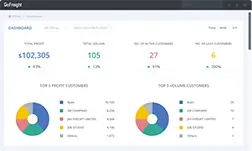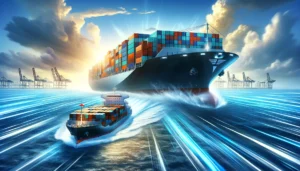Introduction: The What and Why of Bill of Lading
Ever puzzled over the complex labyrinth of paperwork involved in shipping? If you’ve ever had to dive into the world of freight shipping, you’ve no doubt come across the term “bill of lading” multiple times. This legal document serves as a critical part of any shipment process, whether it’s a straightforward domestic transport or an intricate international shipment.
Understanding a bill of lading isn’t just jargon for industry insiders; it’s essential knowledge for everyone involved in the shipping process, from freight forwarders to the end recipients. This key legal document dictates everything from the ownership of the goods to the details of their transport. Failure to understand this can lead to unforeseen obstacles, like hiccups in customs or issues with the transportation of hazardous materials.
But here’s where it gets interesting: there’s more than one type of bill of lading. You’ve got your straight bills, your ocean bills, and various others that govern the shipment rules and regulations. Knowing the distinctions between these is essential, especially if you’re dealing in international trade or complicated freight classifications.
Dive into this guide to unravel all the details and understand why the bill of lading is not just a freight bill but a cornerstone in the logistics and shipping industry.
Bill of Lading Defined
Imagine you’re sending a precious artifact across the ocean. You’d want to make sure everyone involved knows exactly what they’re transporting, how it should be handled, and who’s responsible at each stage. This is where the bill of lading comes into play. It’s not just a piece of paper; it’s a legal document that serves as both a receipt and a contract between the shipper and the carrier. In simpler terms, think of the bill of lading as the DNA of your shipment—unique, identifiable, and crucial to its successful transportation.
What Does Bill of Lading Mean?
The term “bill of lading” might sound arcane, but it’s fundamental to the world of shipping and freight. Whether you’re a shipper, a freight forwarder, or someone awaiting a package, this document outlines the nitty-gritty details of what’s being shipped, its destination, and who’s responsible for each stage of the journey. Most importantly, the bill of lading serves as a legally binding agreement. It functions as a freight bill that outlines costs and as a legal document that can be used in court if disputes arise.
B/L Meaning
The shorthand “B/L” is often used interchangeably with the bill of lading. B/L stands for Bill of Lading, and while it might appear simply as an acronym on a shipping form, understanding its significance is paramount. B/L isn’t just a notation; it’s an acknowledgment of the contract between the shipping line and the shipper. It confirms that a specific list of goods has been received and are slated for transport to a particular destination.
In essence, the bill of lading (or B/L, if you prefer shorthand) is an indispensable tool in the logistics and shipping sector. Whether you’re shipping via air or sea, understanding the functions and implications of this document can save you time, money, and a fair amount of hassle.
Types of Bills of Lading
Picture this: You’re at a bustling port, with cargo ships coming and going, containers being lifted, and everyone around you is speaking a language only comprehensible to those in the know. Amidst this organized chaos, the bill of lading stands as a beacon of clarity. But did you know that not all bills of lading are created equal? Just as a Swiss Army knife has multiple tools for different needs, the world of shipping offers various types of bills of lading, each tailored for specific situations.
Straight Bill vs Ocean Bill
First on the list are the Straight Bill and the Ocean Bill. A Straight Bill is a non-negotiable bill of lading that is designated to a specific consignee, making it a simpler, more direct form of documentation. No one but the designated receiver can claim the shipment, which may sound limiting but is perfect for straightforward transactions.
On the other side, an Ocean Bill is often used in international shipments and is much broader in scope. While the straight bill is like your local bus ticket, an ocean bill is like a global travel pass, allowing the goods to transfer between various transportation methods and even change destination ports while en route.
House Bill, Master Bill, and Order Bill
The nuanced world of shipping doesn’t stop there. We also have the House Bill, issued by a freight forwarder, and the Master Bill, which is issued by the actual carrier. A House Bill is specific to the freight forwarder’s clients, while a Master Bill encompasses all House Bills under a single shipment.
Next, we encounter the Order Bill, a negotiable bill that allows goods to be delivered to the order of a named party. It’s the chameleon of bills of lading, adapting to complex transactions that involve multiple parties.
Negotiable and Non-negotiable Bills
Lastly, we have the concept of Negotiable and Non-negotiable Bills. The former allows the transfer of ownership of goods during transit, making them flexible but also a bit risky. Non-negotiable bills, on the other hand, are rigid but secure, ensuring that the goods can only be released to the named consignee.
In sum, the bill of lading is not just a piece of paper; it’s a versatile tool with various forms, each serving distinct purposes in the complex world of shipping and logistics. Understanding these types can make the difference between a smooth shipment and a logistical nightmare.
How the Freight Bill Works
Navigating the complex world of logistics and freight shipping can feel like walking through a labyrinth. But fear not! At the core of this intricate network is the Freight Bill, a crucial document that acts as the financial spine of the shipping industry. The bill of lading often takes the limelight, but understanding the role of the freight bill is just as vital for a smooth shipping operation.
Freight Bill as a Transportation Hazardous Material Designation
One of the lesser-known but critically important roles of a freight bill is its function as a transportation hazardous material designation. This aspect may sound niche, but it’s crucial for safety and compliance. The freight bill indicates whether the shipment contains any hazardous material, ensuring the proper protocols are followed during transport. This is a legal requirement and deviating from it could result in serious consequences.
How Freight Forwarders Work with Bills of Lading
Now let’s bring in the freight forwarder, the orchestrator of complex shipping scenarios. A freight forwarder’s role is like that of a maestro conducting an orchestra—every detail matters. Working closely with bills of lading, freight forwarders use freight bills to get a comprehensive snapshot of the shipment. Whether dealing with a straight bill, ocean bill, or any other type, a freight forwarder utilizes the information to efficiently manage freight shipments.
NMFC Freight Class and Other Categorizations
Moving on to NMFC Freight Class, or the National Motor Freight Classification. It’s a categorization system that helps to standardize freight pricing. Understanding NMFC classes is crucial for any player in the shipping industry as it influences the cost, and by extension, the freight bill. Different types of goods have different classes, which are documented in the freight bill to give both the shipper and the freight carrier a clear understanding of the shipment’s nature.
So, the next time you see a freight bill, remember it’s not just a piece of paper—it’s a complex, multi-functional tool that ensures the safety, legality, and efficiency of the shipping process. It plays a vital role in international trade, is pivotal for freight forwarders, and contains all the details you need for a successful shipment.
The Legal Aspects of Bills of Lading
In the intricate dance of international trade and logistics, one document reigns supreme: the Bill of Lading. Far from just a mere shipping receipt or an itinerary, the bill of lading is a legal document that can either smooth the way for seamless transactions or become a Pandora’s box of complications and disputes. Its legal authority impacts not just the shipper and the carrier, but often stretches its influence to banks, insurance companies, and governmental bodies.
Bill of Lading as a Legal Document
The gravitas of a bill of lading stems from its status as a legal document issued by a transportation company. This document serves several main functions: it is a receipt issued for the goods being transported, a title document that can be negotiable or non-negotiable, and a legally binding contract that lays out the terms and conditions between the shipper and the carrier.
Importance in International Trade and Logistics
In the realm of international trade and logistics, the bill of lading acts as a passport for goods crossing borders. It’s a primary document that must be meticulously filled out to ensure no hiccups occur in the complex processes that span across multiple jurisdictions and regulatory environments. A single mistake or omission can lead to delays, fines, or even confiscation of the shipment.
Legally Binding Terms and Conditions
When it comes to the contractual aspects, the bill of lading sets forth the legally binding terms and conditions that govern the entire shipping process. From shipment bills specifying what’s being transported to special instructions for handling, all the details are outlined, making it an important document for all parties involved.
In sum, understanding the legal aspects of bills of lading is not just an academic exercise—it’s a necessity for anyone involved in the shipping and freight industry.
Bill of Lading Example and How to Issue One
Navigating the complex world of shipping? Then you’ll definitely come across one essential element: the Bill of Lading. This cornerstone document is your best friend when it comes to shipping and receiving goods, and getting it right is non-negotiable. But what does a typical bill of lading look like, and how exactly do you issue one? Whether you’re dealing with electronic bills or traditional paper bills, this guide breaks down what you need to know, including the role of a freight forwarder in the process.
Bill of Lading Examples for Different Types
Before diving into the “how,” it’s crucial to understand the “what.” There are various types of bills of lading, each with its own set of rules and requirements. You could encounter a straight bill, used mainly for non-negotiable shipping arrangements, or an ocean bill, which governs the shipping of goods over international waters. Then there’s the house bill and master bill, each serving unique roles in the shipping process. Knowing which type to use and when is crucial; for example, an order bill is often necessary when the shipping process involves multiple parties.
Electronic Bill vs Paper Bill
In today’s digital age, you’ll find two main formats: the electronic bill and the paper bill. While electronic bills offer speed and efficiency, they also require stringent security measures. Paper bills, though considered old-fashioned, have the advantage of being universally accepted and are often required for certain types of shipments. Your choice between the two will often depend on both the shipper and the carrier’s requirements.
How a Freight Forwarder Can Issue a Bill
If you’re using a freight forwarder, they can simplify the process of issuing a bill of lading for you. They’re responsible for making the necessary arrangements with the shipping lines and have a keen understanding of NMFC freight class and other categorizations.
The freight forwarder will create the bill of lading, including all necessary details like cargo description and special instructions, and ensure that it meets all legal and operational requirements.
In conclusion, issuing a bill of lading is a crucial, yet intricate process that involves various steps and decisions. Failure to issue an appropriate bill can have serious implications, but with the right knowledge and assistance, you can navigate this aspect of shipping like a pro.
Do’s and Don’ts – Clean Bill, Dirty Bill, and More
In the labyrinthine world of shipping and freight, the bill of lading is your North Star. This legal document is the bedrock upon which your entire shipping operation stands, but not all bills are created equal. In this section, we’ll unravel the importance of a clean bill over a dirty bill, teach you how to reconcile shipping invoices, and differentiate between primary documents and secondary ones like purchase orders.
Importance of a Clean Bill Over a Dirty Bill
The difference between a clean and a dirty bill can impact your entire freight shipment process. A clean bill is a receipt issued without any reservations by the shipping line; it states that the cargo is in perfect condition. This is crucial for both the shipper and the carrier as it establishes trust and mitigates risks. A dirty bill, however, flags issues with the cargo — perhaps it’s broken or improperly packaged. Such discrepancies can cause delays and increased costs, making a clean bill the gold standard in international trade and transportation.
How to Reconcile Shipping Invoices
Mistakes can happen, even in the most disciplined operations. Discrepancies between the bill of lading and shipping invoices are not uncommon. Knowing how to reconcile these documents is essential. The bill of lading, being the primary document, takes precedence over secondary documents like purchase orders. Always cross-reference the details to ensure that the freight carrier has provided all the services agreed upon, and that the bill aligns with the terms set in the original contract issued.
Primary Document vs Other Documents like Purchase Order
The bill of lading serves as the primary document in the shipping process, often superseding other documents like purchase orders in legal importance. While a purchase order initiates the buying process, it’s the bill of lading that legally binds the parties involved and serves as a title document. So, when you’re dealing with shipping lines or international carriers, remember: it’s the bill of lading that holds the ultimate power.
Navigating the sea of shipping documentation can be daunting. But by understanding these do’s and don’ts, you’ll be well on your way to mastering the main functions of this important document in your shipping toolbox.
How Bill of Lading Affects International Shipping
If shipping were a global game of chess, then the bill of lading would undoubtedly be the queen. Agile, powerful, and indispensable. In the realm of international shipping, understanding the intricacies of the bill of lading can mean the difference between a successful move or a costly mistake. Let’s explore its pivotal role through the lens of ocean bills, the responsibilities of shipping lines and international carriers, and delve into how it serves insurance purposes and special instructions.
Ocean Bill in the Context of International Shipment
When your goods are sailing over international waters, the ocean bill is your passport for safe and legal transport. This specific type of bill of lading not only serves as a contract but also acts as a title document for the goods being shipped.
In international trade, where the stakes are high and margins thin, ensuring your ocean bill is meticulously prepared can save you from a world of hurt, from legal issues to shipping delays.
Role of Shipping Lines and International Carriers
Shipping lines and international carriers are the unsung heroes that make global trade possible, and their responsibilities are clearly outlined in the bill of lading. Whether it’s space allocation, adherence to special instructions, or handling cargo space, these entities look to the bill of lading as their ultimate guide. In turn, their performance can be assessed based on how well they comply with this legally binding document.
Insurance Purposes and Special Instructions
Don’t underestimate the bill of lading when it comes to insurance. In cases of lost or damaged goods, this document is your first line of defense. It’s not just a piece of paper; it’s a legal instrument that can be presented in court. Moreover, any special instructions for handling your shipment—be it temperature-sensitive items or fragile goods—need to be explicitly mentioned here for insurance purposes.
In a world connected by seas and oceans, the bill of lading is your navigator, steering you clear from the rocky shores of risk and into the smooth waters of shipping success.
Common Questions about Bill of Lading
Navigating the complexities of bills of lading can be a daunting task, especially for those new to the shipping and logistics industry. Here, we’ve compiled a list of frequently asked questions to help clear up some of the confusion.
What is a Bill of Lading?
A bill of lading is a legally binding document that serves as a contract between the shipper and the carrier. It details the type, quantity, and destination of the goods being shipped and acts as a receipt when the goods are delivered.
Is a Bill of Lading the Same as a Freight Bill?
No, while a bill of lading serves multiple roles including a contract and a cargo receipt, a freight bill is specifically an invoice for the shipping charges. It’s essential to differentiate the two, as each serves different legal and operational purposes.
What Does “Straight Bill” Mean?
A straight bill is a non-negotiable bill of lading. This means it specifies a consignee who must be the one to receive the shipment. It doesn’t allow the ownership of the goods to be transferred while in transit.
What are Ocean Bills and How Do They Differ from Other Types?
An ocean bill is specific to sea shipments and typically involves international trade. They can be either negotiable or non-negotiable and often require more complex terms due to international regulations and customs requirements.
What’s a Clean Bill vs. a Dirty Bill?
A clean bill is a bill of lading without any clauses or notations that indicate the goods are damaged or incomplete. A dirty bill, on the other hand, includes notations that could limit the carrier’s liability.
How Can I Reconcile Shipping Invoices?
Reconciling shipping invoices means verifying all charges, terms, and notations on the invoices against the services actually rendered. Any discrepancies should be immediately addressed with the carrier to avoid legal and financial issues later on.
Conclusion: The Role of Bill of Lading in Modern Shipping
As we’ve navigated through the labyrinthine world of bill of lading, one thing stands clear—understanding this document is crucial for anyone involved in shipping or logistics. It’s not just a paper trail; it’s a legally binding contract, a guide, and a guarantor all wrapped into one. Whether it’s a straight bill for domestic transport or an ocean bill that crosses international borders, understanding the intricacies is essential.
We’ve delved deep into its many facets, from the nitty-gritty details of freight bills to the complex legalities. We’ve looked at how freight forwarders issue bills and manage NMFC freight classes. We’ve also explored its role in international trade, the importance of clean bills, and even how to reconcile shipping invoices.
In a world where shipping involves not just moving goods but also fulfilling legal, safety, and financial obligations, a firm grip on your bill of lading practices can make or break your operations. Therefore, as we sail away from this discussion, take with you the knowledge that mastering this document is not just a task but a necessity for succeeding in modern shipping.





